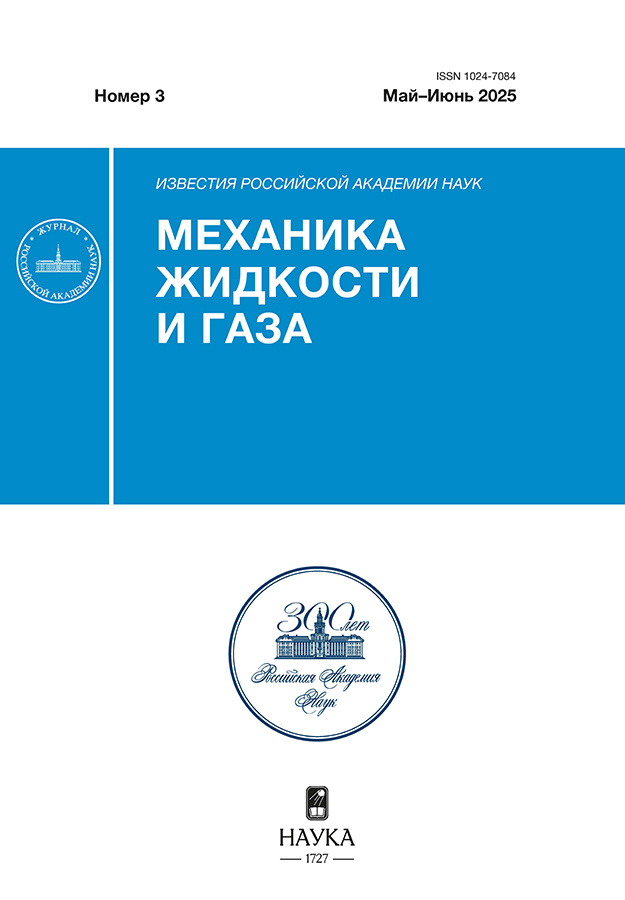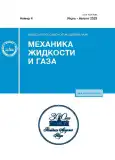ЧИСЛЕННОЕ ИССЛЕДОВАНИЕ ВЛИЯНИЯ СТРУКТУРЫ СИСТЕМЫ ТРЕЩИН НА ФИЛЬТРАЦИЮ ЖИДКОСТИ В ПОРОУПРУГОЙ СРЕДЕ
- Авторы: Легостаев Д.Ю.1, Родионов С.П.1
-
Учреждения:
- Тюменский филиал Института теоретической и прикладной механики им. С.А. Христиановича СО РАН
- Выпуск: № 4 (2023)
- Страницы: 93-107
- Раздел: Статьи
- URL: https://journals.rcsi.science/1024-7084/article/view/135102
- DOI: https://doi.org/10.31857/S1024708422600543
- EDN: https://elibrary.ru/WJPBJV
- ID: 135102
Цитировать
Полный текст
Аннотация
Рассматривается двумерная однофазная фильтрация слабосжимаемой жидкости в деформируемой трещиновато-пористой среде. Для совместного моделирования процессов фильтрации и связанного с ними изменения напряженно-деформированного состояния среды использована модель пороупругой среды, моделирование трещиноватости выполнено с помощью модели дискретных трещин. Трещины в рассматриваемой области имели случайное положение и ориентацию, распределение трещин по длинам подчинялось степенному закону. Исследовалась зависимость фильтрационных свойств трещиновато-пористой среды от ее напряженно-деформированного состояния и структуры системы трещин. Численное исследование выполнено для вариантов систем трещин, полученных путем множественной случайной генерации. Установлено, что фильтрационные свойства трещиновато-пористой среды определяются главным образом структурой системы трещин, характеризуемой параметром перколяции. Показано, что существенное влияние напряженно-деформированного состояния среды на ее фильтрационные свойства наблюдается для только связных систем трещин. Предложена формула для аппроксимации зависимости эквивалентной проницаемости трещиновато-пористой среды от параметров характеризующих связность системы трещин, напряженно-деформированное состояние среды, деформационные и фильтрационные свойства трещин.
Об авторах
Д. Ю. Легостаев
Тюменский филиал Института теоретической и прикладной механики им. С.А. Христиановича СО РАН
Email: legostaevdy@yandex.ru
Россия, Тюмень
С. П. Родионов
Тюменский филиал Института теоретической и прикладной механики им. С.А. Христиановича СО РАН
Автор, ответственный за переписку.
Email: rodionovsp@bk.ru
Россия, Тюмень
Список литературы
- Smirnov N.N., Nikitin V.F., Kolenkina (Skryleva) E.I., Gazizova. D. R. Evolution of a phase interface in the displacement of viscous fluids from a porous medium // Fluid Dynamics. 2021. V. 56. № 1. P. 79–92. https://doi.org/10.1134/S0015462821010122
- Nikitin V.F., Skryleva E.I., Weisman Yu. G. Control of capillary driven fluid flows for safe operation of spacecraft fluid supply systems using artificial porous media // Acta Astronautica. 2022. V. 194. P. 544–548. https://doi.org/10.1016/j.actaastro.2021.12.009
- Dushin V.R., Smirnov N.N., Nikitin V.F., Skryleva E. I., Weisman Yu.G. Multiple capillary-driven imbibition of a porous medium under microgravity conditions: Experimental investigation and mathematical modeling // Acta Astronautica. 2022. V. 193. P. 572–578. https://doi.org/10.1016/j.actaastro.2021.06.054
- Kiselev A.B., Kay-Zhui L., Smirnov N.N., Pestov D.A. Simulation of Fluid Flow through a Hydraulic Fracture of a Heterogeneous Fracture-Tough Reservoir in the Planar 3D Formulation // Fluid Dynamics. 2021. V. 56. № 2. P. 164–177. https://doi.org/10.1134/S0015462821020051
- Smirnov N., Li K., Skryleva E., Pestov D., Shamina A., Qi C., Kiselev A. Mathematical Modeling of Hydraulic Fracture Formation and Cleaning Processes // Energies. 2022. V. 15. № 6. https://doi.org/10.3390/en15061967
- Голф-Рахт Т.Д. Основы нефтепромысловой геологии и разработки трещиноватых коллекторов. M.: Недра, 1986. 608 с.
- Nelson R.A. Geologic Analysis of Naturally Fractured Reservoirs. Gulf Professional Publishing, 2001. 352 p.
- Пичугин О.Н., Родионов С.П., Соляной П.Н., Гаврись А.С., Косяков В.П., Кошеверов Г.Г. Принципы оптимизации систем заводнения месторождений, осложненных малоамплитудными тектоническими нарушениями // Российская нефтегазовая техническая конференции SPE, Москва, Россия. 2015.
- Karimi-Fard M., Durlofsky L.J., Aziz K. An Efficient Discrete-Fracture Model Applicable for General-Purpose Reservoir Simulators // SPE Journal. 2004. V. 9. № 2. P. 227–236. https://doi.org/10.2118/88812-PA
- Garipov T.T., Karimi-Fard M., Tchelepi H.A. Discrete fracture model for coupled flow and geomechanics // Computational Geosciences. 2016. V. 20. № 1. P. 149–160. https://doi.org/10.1007/s10596-015-9554-z
- Bai M. On equivalence of dual-porosity poroelastic parameters // Journal of Geophysical Research: Solid Earth. 1999. V. 104. № B5. P. 10461–10466. https://doi.org/10.1029/1999JB900072
- Chen H.-Y., Teufel L.W. Coupling Fluid-Flow and Geomechanics in Dual-Porosity Modeling of Naturally Fractured Reservoirs – Model Description and Comparison// SPE International Oil Conference and Exhibition in Mexico. 2000. https://doi.org/10.2118/59043-MS
- Rutqvist J., Stephansson O. The role of hydromechanical coupling in fractured rock engineering // Hydrogeology Journal. 2003. V. 11. № 1. P. 7–40. https://doi.org/10.1007/s10040-002-0241-5
- Biot M.A. General Theory of Three-Dimensional Consolidation // Journal of Applied Physics. 1941. V. 12. № 2. P. 155–164. https://doi.org/10.1063/1.1712886
- Coussy O. Poromechanics. John Wiley and Sons, Ltd, 2004. 315 p.
- Gutierrez M., Youn D.-J. Effects of fracture distribution and length scale on the equivalent continuum elastic compliance of fractured rock masses // Journal of Rock Mechanics and Geotechnical Engineering. 2015. V. 7. № 6. P. 626–637. https://doi.org/10.1016/j.jrmge.2015.07.006
- Liu R., Li B., Jiang Y., Huang N. Review: Mathematical expressions for estimating equivalent permeability of rock fracture networks // Hydrogeology Journal. 2016. V. 24. № 7. P. 1623–1649. https://doi.org/10.1007/s10040-016-1441-8
- Bonnet E., Bour O., Odling N.E., Davy P., Main I., Cowie P., Berkowitz B. Scaling of fracture systems in geological media // Reviews of Geophysics. 2001. V. 39. № 3. P. 347–383. https://doi.org/10.1029/1999RG000074
- Bogdanov I.I., Mourzenko V.V., Thovert J.-F., Adler P.M. Effective permeability of fractured porous media in steady state flow // Water Resources Research. 2003. V. 39. № 1. https://doi.org/10.1029/2001WR000756
- Hyman J.D., Karra S., Carey J.W., Gable C.W., Viswanathan H., Rougier E., Lei Z. Discontinuities in effective permeability due to fracture percolation // Mechanics of Materials. 2018. V. 119. P. 25–33. https://doi.org/10.1016/j.mechmat.2018.01.005
- Jafari A., Babadagli T. A Sensitivity Analysis for Effective Parameters on 2D Fracture-Network Permeability // SPE Reservoir Evaluation & Engineering. 2009. V. 12. № 3. P. 455–469. https://doi.org/10.2118/113618-PA
- Bour O., Davy P. Connectivity of random fault networks following a power law fault length distribution // Water Resources Research. 1997. V. 33. № 7. P. 1567–1583. https://doi.org/10.1029/96WR00433
- de Dreuzy J.-R., Davy P., Bour O. Hydraulic properties of two-dimensional random fracture networks following a power law length distribution: 1. Effective connectivity // Water Resources Research. 2001. V. 37. № 8. P. 2065–2078. https://doi.org/10.1029/2001WR900011
- de Dreuzy J.-R., Davy P., Bour O. Hydraulic properties of two-dimensional random fracture networks following a power law length distribution: 2. Permeability of networks based on lognormal distribution of apertures // Water Resources Research. 2001. V. 37. № 8. P. 2079–2095. https://doi.org/10.1029/2001WR900010
- Masihi M., King P.R. Connectivity Prediction in Fractured Reservoirs With Variable Fracture Size: Analysis and Validation // SPE Journal. 2008. V. 13. № 1. P. 88–98. https://doi.org/10.2118/100229-PA
- Witherspoon P.A., Wang J.S.Y., Iwai K., Gale J.E. Validity of Cubic Law for fluid flow in a deformable rock fracture // Water Resources Research. 1980. V. 16. № 6. P. 1016–1024. https://doi.org/10.1029/WR016i006p01016
- Gao K., Lei Q. Influence of boundary constraints on stress heterogeneity modelling //Computers and Geotechnics. 2018. V. 99. P. 130–136. https://doi.org/10.1016/j.compgeo.2018.03.003
- Tang T., Hededal O., Cardiff P. On finite volume method implementation of poro-elasto-plasticity soil model // International Journal for Numerical and Analytical Methods in Geomechanics. 2015. V. 39. № 13. P. 1410–1430. https://doi.org/10.1002/nag.2361
- Kim J., Tchelepi H.A., Juanes R. Stability and convergence of sequential methods for coupled flow and geomechanics: Fixed-stress and fixed-strain splits // Computer Methods in Applied Mechanics and Engineering. 2015. V. 200. № 13. P. 1591–1606. https://doi.org/10.1016/j.cma.2010.12.022
- Geuzaine C., Remacle J.-F. Gmsh: A 3-D finite element mesh generator with built-in pre- and post-processing facilities // International Journal for Numerical Methods in Engineering. 2009. V. 79. № 11. P. 1309–1331. https://doi.org/10.1002/nme.2579
- Легостаев Д.Ю., Родионов С.П. Численное исследование двухфазной фильтрации в трещиновато-пористой среде на основе моделей пороупругости и дискретных трещин // Прикладная механика и техническая физика. 2021. Т. 62. № 3. С. 126–136. https://doi.org/10.15372/PMTF20210312
- Berre I., Doster F., Keilegavlen E. Flow in Fractured Porous Media: A Review of Conceptual Models and Discretization Approaches // Transport in Porous Media. 2019. V. 130. № 1. P. 215–236. https://doi.org/10.1007/s11242-018-1171-6
- Басниев К.С., Кочина И.Н., Максимов В.М. Подземная гидромеханика. М.: Недра, 1993. 416 p.
- Lei Q., Wang X., Min K.-B., Rutqvist J. Interactive roles of geometrical distribution and geomechanical deformation of fracture networks in fluid flow through fractured geological media // Journal of Rock Mechanics and Geotechnical Engineering. 2020. V. 12. № 4. P. 780–792. https://doi.org/10.1016/j.jrmge.2019.12.014
- Hestir K., Long J.C.S. Analytical expressions for the permeability of random two-dimensional Poisson fracture networks based on regular lattice percolation and equivalent media theories // Journal of Geophysical Research: Solid Earth. 1990. V. 95. № B13. P. 21565–21581. https://doi.org/10.1029/JB095iB13p21565
- Berkowitz B., Balberg I. Percolation theory and its application to groundwater hydrology // Water Resources Research. 1993. V. 29. № 4. P. 775–7941. https://doi.org/10.1029/92WR02707
Дополнительные файлы















